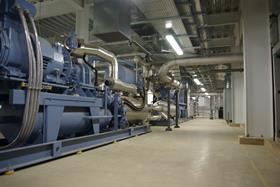
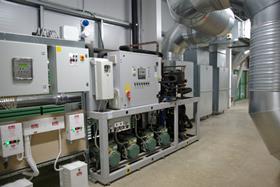
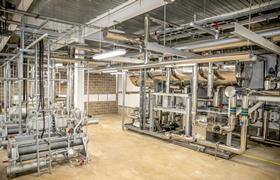
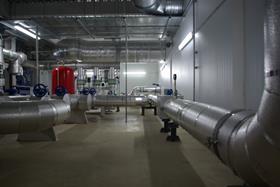
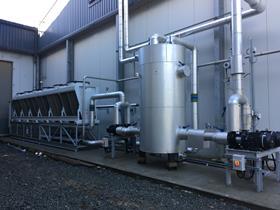
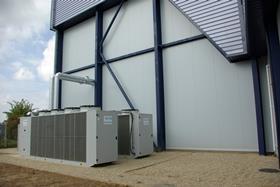

Over the last 10 years JD Cooling Systems has witnessed a distinct change in the attitude of end users in the fresh produce sector. Many smaller growers and suppliers have been swallowed up by a number of rapidly expanding ‘super suppliers’ to the major retailers.
These suppliers were under pressure to expand their facilities to cope with the increased volumes of business; however, in conjunction with this growth came a big squeeze on the margins being offered. Not surprisingly there became more and more focus on reducing energy costs and optimising plant usage to maximise the returns on investment.
Changes in conventional refrigeration
In the background to this, the global understanding of the impact of different refrigerants on the environment brought about restrictions on types of refrigerant that could be used. The first of these changes saw the banning of CFCs, which were identified as harmful to the ozone layer. This unexpected change led to unwanted disruption and expenditure for end users. Having been through the pains of this change in legislation, end users were soon hit with a second round of environmental restrictions when it was discovered that while HCFCs weren’t damaging the ozone layer, they were contributing to global warming.
Understandably no end users were enthusiastic about the resulting additional disruption and expenditure. Due to the vastness of the task this reduction in HCFCs was in the form of a phase down, rather than an all-out ban (as in the case of CFCs) to slow down the effect of their release to atmosphere. As this change was a phase down rather than a ban, many suppliers to the industry were overlooking the impact of additional future restrictions and simply using an ‘it’s legal now’ approach.
JD Cooling, however sensed a real and strong desire by many end users within the fresh produce sector to follow a different path and futureproof any new investment in major refrigeration projects.
Future thinking
In 2014, sensing this shift in ‘conventional’ refrigeration usage and realising that in order to be able to offer their clients the best solution for their new facility, (whatever the technical demands of such a design may be) JD Cooling launched its sister company – JD Industrial Cooling Systems (JDI) – specifically created to offer more natural solutions (ammonia, propane, CO2) to clients.
A fine example of such an evolution within the fresh produce sector is where major supplier Albert Bartlett & Sons (Airdrie) recently awarded JDI a large project to install ammonia and ammonia/glycol systems to its new production lines at its Scottish HQ. Many years ago, Albert Bartlett had previously worked with JDI’s parent company to install ‘free cooling’ to its dispatch storage areas and computer server rooms, effectively using outside ambient air to provide cooling when the temperature was sufficiently cold enough.
Chief operations officer Colin Campbell discussed plans for an ambitious project to expand into fresh prepared potato products from its Airdrie factory, realising that the application of energy-efficient and sustainable natural refrigerants was vital to futureproof this new venture in an increasingly competitive marketplace.
JD Cooling, based in King’s Lynn with offices in Manchester, Bristol and Scotland, was recently crowned ‘Contractor of the Year’ at two separate national industry awards in 2017 and 2018 thanks to its innovative energy-saving ideas such as using heat recovery for defrost along with adaptive temperature control, dynamic system optimisation and other such designs.
Heat Recovery
A great stride towards making such efficient systems feasible has been the move towards central glycol cooling systems. Traditionally large factories, packhouses and storage complexes would have applied multiple individual systems to serve the various areas across a site. This meant that the huge amount of heat being rejected by the cooling systems was spread out across a wide area and therefore difficult to harness into any common heat recovery system. The centralised nature of a glycol system means that heat can now be recovered from one central location at the main glycol chiller plantroom. This greatly increases the feasibility of integrating heat recovery systems to a site, offering very attractive paybacks for the investment through reduced utility bills and lower overall service and maintenance costs.
Food manufacturing
In 2015, Greencore Food to Go in Northampton opened its new purpose-built facility spanning over four operational floors – built specially to support the demands of one of the high street’s largest suppliers of pre-packed sandwiches. As part of the build, there was a substantial amount of natural refrigeration installed, including secondary cooling systems driven by ammonia chillers, adiabatic cooling and water-to-water ammonia driven heat pumps. The ammonia heat pumps were designed to recover waste heat from the cooling process, boosting the temperature to supply hot water for all domestic use and supplying hygiene stations hot water to all wash down areas. As a result of the innovative and natural design, the building is now highly efficient, environmentally sustainable and HFC free, which will, going forward, achieve energy cost savings to the client.
Ripening rooms
Typically, ripening rooms use direct expansion refrigeration to deliver cooling at the end of a ripening cycle to stabilise the fruit temperature. Prior to the cooling demand there is a 24 to 48-hour demand for heating, which is conventionally delivered by electric heat elements within the room. Once the fruit is ripened to the optimum condition, the heat within the pulp needs to be removed quickly to ensure that the fruit does not over-ripen. Traditional cooling systems reject this heat to the atmosphere via air-cooled condensers, whereas JD Cooling has designed a system whereby it uses the waste heat from the refrigeration cycle to provide the heating for the ripening process. This is a process that is enhanced greatly when applied to multiple rooms.
This system has been applied at one of the UK’s largest fruit producers A Gomez (Canterbury), across four of their ripening rooms – using the heat recovery process rather than electric. In addition, working closely with the largest avocado producer in the UK, JD Cooling has demonstrated potential cost savings for the client of £1.50 per pallet/per cycle using this heat recovery system. It is believed that if applied across the UK’s largest producers, these savings could run into the hundreds and thousands per year.
Potato conditioning
In the ever-increasing push by suppliers to the major retailers for higher quantity and quality fresh produce, potato suppliers in the industry have identified the potential to address both of these vital factors within one critical part of their packing process- enhanced conditioning systems.
Typically, potatoes are stored at 3oC for three to 10 months in readiness for delivery to the packhouse. Upon arrival at the packhouse, it is not possible to pass the crop through the packing lines without damage until they have reached an optimum temperature of 10-12oC. Packing crop below this temperature is known to dramatically increase product damage through bruising, ‘thumbnailing’ etc. Equally, too long at these higher temperatures will shorten the shelf life after packing as sprouting can occur. Traditionally heat is applied to the crop following storage either by electric / gas heaters installed in various ventilation systems for conditioning the crop.
Greenvale, a major UK potato packer whom JD Cooling has worked with for many years, boasts of a state-of-the-art heat recovery system, which will now not only deliver more uniformed crop conditioning, but also allow target temperatures to be achieved more quickly with reduced energy consumption. In this instance JD Cooling applied forced air ventilation to the boxed crop using either external ambient air, when this was available at the correct temperature, or by using waste heat recovered from the refrigeration system.
Taking into account the environmental restrictions on the use of refrigerants and indeed potential logistical changes resulting from Britain leaving the common market, it is more important now than ever before that UK growers, producers and importers are equipped with the best possible advice on reducing running costs (including maximising energy recovery) and providing the ideal conditions to ensure the longest possible storage and shelf life for their fresh produce, not simply advice based on the product or service capabilities of the advisors.



